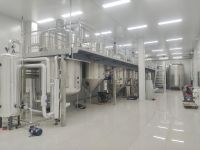153-0373-2222
138-3908-0089
The new product, Silybum marianum seed oil, is made from the seeds of the Silybum marianum plant, a member of the Asteraceae family. The oil is produced through a process of cold pressing and filtration. On April 16, 2014, the National Health and Family Planning Commission approved Silybum marianum seed oil as a new food ingredient, with the stipulation that it is not to be used in infant food.
1. Extraction Workshop Production Process
Due to the small production scale, and to ensure the full retention of silymarin in the cake, the oil extraction process is designed to minimize the process flow and reduce heat damage while maintaining high oil yield and product quality. This is achieved through a two-stage cold pressing method. The process flow is as follows:
Silybum marianum seeds are first screened and magnetically separated to remove sand, coal slag, mud, dust, husks, and magnetic impurities. They are then softened at a temperature of around 60°C. Temperatures above this can damage the silymarin, while temperatures below this do not achieve the softening effect. Softened materials are then sent to the first press for extraction, followed by a second press. The crude oil obtained from both pressings is settled and filtered before being sent to the refining workshop. The pressed cake is broken and sent to the silymarin extraction workshop for the extraction of silymarin.
2. Refining Workshop Production Process
The crude oil can be refined to produce either a first-grade oil or a cooking oil. The process for producing cooking oil is as follows:
Aqueous alkali solution of the required concentration is prepared based on the acid value of the crude oil. The oil is stirred and heated to about 45°C in the alkali refining pot, and then the prepared alkali solution is added. The mixture is stirred and kept at this temperature for 20 to 60 minutes until the oil and soap particles are separated. The temperature is then raised to 60°C to 70°C at a rate of 1°C to 1.5°C per minute, and the mixture is stirred for another 10 minutes. When the oil and soap begin to separate, stirring is stopped, and the mixture is allowed to settle for 6 to 8 hours. The bottom layer is drained, and the oil is transferred to the water washing pot for washing. Water is added at a rate of 10% to 15% of the oil weight, at a temperature of 85°C to 90°C, and washed 2 to 3 times. The oil is then de-colored. The de-coloring temperature is 90°C to 105°C, with the addition of activated clay at 2% to 5% of the oil weight, for about 30 minutes, with a vacuum of about 96 kPa. The de-colored oil is filtered through a plate filter to remove the clay, then sent to the deodorizing pot for deodorization. The heating source is thermal oil. Steam is injected when the temperature reaches about 150°C, with the amount of steam injection carefully controlled to avoid splashing. The deodorization temperature is 210°C to 240°C, for 2.5 to 4 hours, with a residual pressure of 0.53 kPa in the pot.
After deodorization, the oil is cooled in a cooler, filtered, and then pumped into the finished oil tank. The Hongyang refining process can be adjusted according to specific requirements to produce either first-grade oil or cooking oil.
3. Conclusion
3.1 This process has a short production line, simple equipment matching, easy operation, and low investment.
3.2 The pressed cake retains a certain amount of silymarin from the raw material, providing favorable conditions for the extraction of silymarin.
3.3 The oil contained in the cake is separated in the extraction workshop, minimizing oil loss.
3.4 After oil extraction and silymarin extraction, the residue from the Silybum marianum seeds contains 36.4% starch and 23% protein, which can be used as animal feed.
3.5 Silybum marianum oil is a healthy edible oil worth promoting.



























































